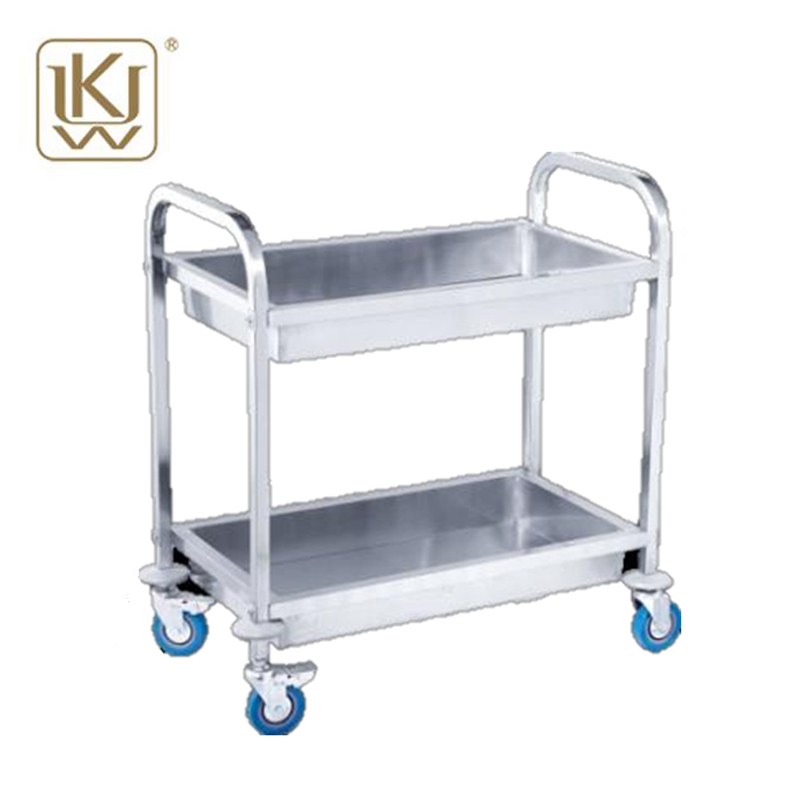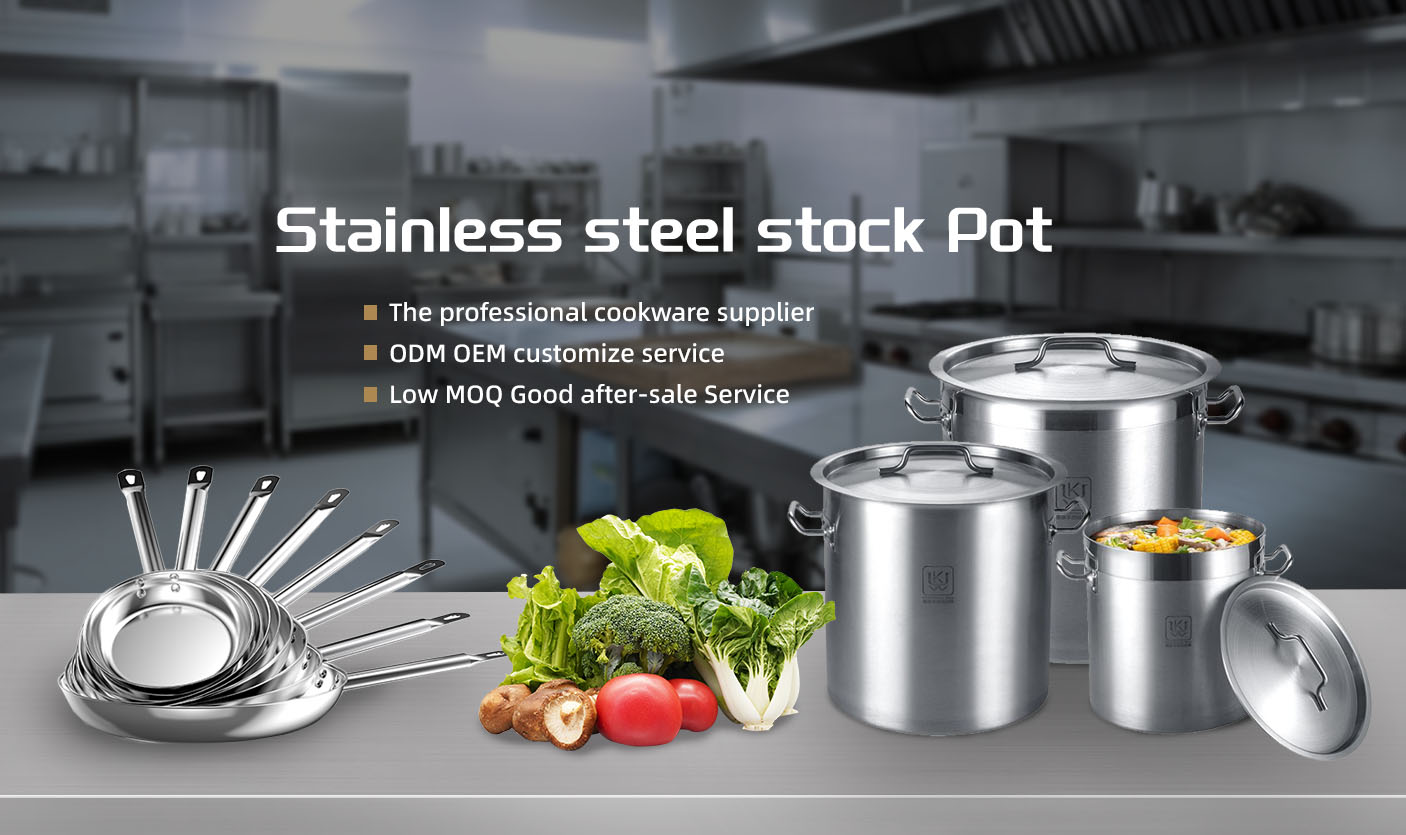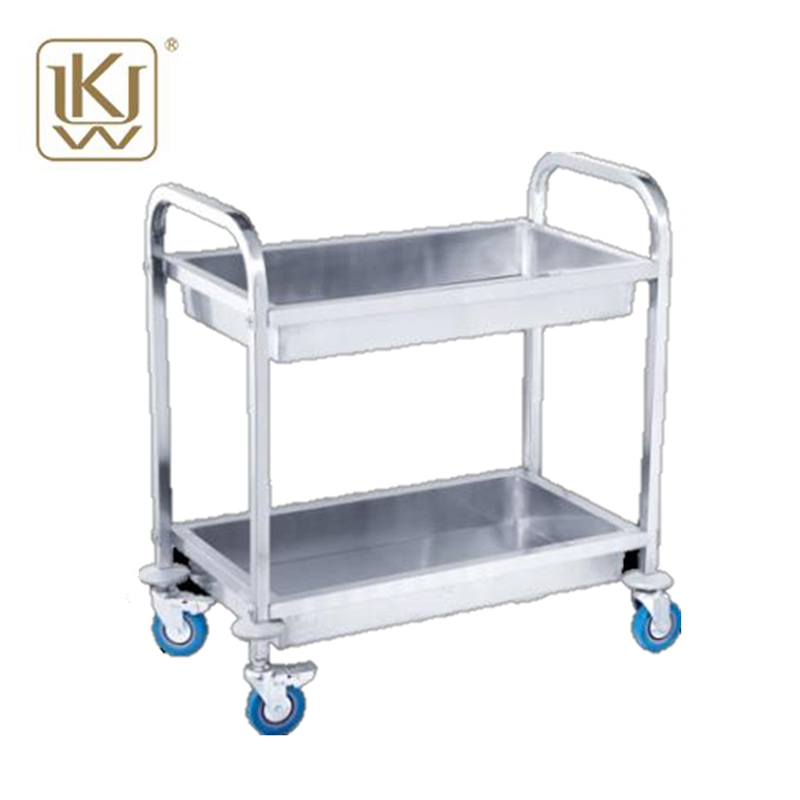Stainless Serving Cart
- Product Information
Stainless Serving Cart is a stainless steel trolley designed for catering services, aiming to provide efficient and hygienic food transportation solutions for restaurants, hotels, hospitals and other places. It is made of high-quality stainless steel, with a smooth and easy-to-clean surface, excellent corrosion resistance and durability. The trolley is usually equipped with two or more layers of shelves, and each layer is surrounded by a guardrail frame to effectively prevent items from sliding during transportation. There are four universal wheels installed at the bottom, at least two of which are equipped with brakes to ensure the stability of the trolley when moving and parking. Users can easily place various tableware, food and drinks on the trolley, and use its flexible wheels to quickly transport them between different areas to improve service efficiency and quality.

Stainless Serving Cart Parameters:
| CODE | Dimension(mm) |
| BRD-L2 | 950*500*950 |
| BRD-M2 | 850*450*900 |
| BRD-S2 | 750*400*835 |
Stainless Serving Cart Features:
High-quality stainless steel material
Stainless Serving Carts are made of 304 stainless steel, which contains 18% - 20% chromium and 8% - 10.5% nickel, making it highly resistant to corrosion and oxidation. With a hardness of around HV200, it is strong enough to withstand the various pressures of daily use and is not easily deformed or damaged. After professional testing, 304 stainless steel is 7 - 8 times more resistant to corrosion than ordinary carbon steel in a simulated catering environment, and it maintains good performance even when exposed to food residues, detergents and humid environments for a long time. This high-quality stainless steel material ensures the long-term stability and reliability of the trolley, providing users with detailed information.
Rust and corrosion resistance
The 304 stainless steel material of the trolley gives it excellent rust and corrosion resistance. In catering services, trolleys are often exposed to substances such as water, oil, acidic or alkaline food residues, and detergents, but this material can effectively resist the corrosion of these substances. After professional testing, there was no obvious corrosion on the surface of the trolley after being placed continuously for 72 hours in a simulated harsh catering environment (containing high-concentration sodium chloride solution and acidic substances). Compared with ordinary carbon steel trolleys, its service life is extended by about 3-4 times. This anti-rust and corrosion resistance ensures that the trolley maintains a good appearance and performance during long-term use, reduces maintenance costs, and extends its service life.
Moderate sheet thickness
The shelf sheet thickness of the trolley is 1.0-1.2mm. This thickness design has been precisely calculated and repeatedly tested to achieve a balance between lightness and durability while ensuring the structural strength of the trolley. Compared with ordinary stainless steel trolleys with a thickness of 0.8mm, its load-bearing capacity is increased by about 25% and its service life is extended by about 30%. This moderate sheet thickness not only ensures that the trolley can withstand heavier items, but also maintains the flexibility and easy operation of the trolley, which facilitates staff to quickly transport between different areas.
Superb welding quality
The frame and shelves of the trolleys are made with superb welding technology. The welding points have been strictly inspected and have high welding strength to withstand repeated weight impacts. The tensile strength of each welding point reaches 300-350MPa, ensuring that the trolley will not become loose or damaged during long-term use. Compared with some similar products on the market that use simple riveting or low-quality welding, its structural stability is improved by about 40%. This superb welding quality provides a solid foundation for the trolley, ensuring its safety and reliability under high-intensity use.
Strong load-bearing capacity
Stainless Serving Carts have a strong load-bearing capacity. Each shelf layer can withstand a weight of 50-70kg, and the total load capacity of the whole vehicle can reach 100-140kg. This data has been verified by actual load tests by professional institutions to ensure that the trolley can operate stably within the specified load range without deformation or damage. Compared with similar products with a normal load capacity of about 80kg, its load capacity is increased by about 25% - 75%. This powerful load capacity enables the trolley to meet the needs of transporting a large number of items in catering services, improving service efficiency and quality.
Two-layer practical design
The trolley adopts a two-layer shelf design, and the size of each shelf is 600mm (length) × 400mm (width), providing sufficient placement space. The two-layer design can not only meet the item transportation needs in most catering service scenarios, but also effectively utilize space to avoid the problem of trolleys being too high, unstable or difficult to operate due to too many layers. Compared with single-layer trolleys, its item transportation efficiency is increased by about 100%; compared with trolleys with three or more layers, the two-layer design has better stability and flexibility while ensuring practicality, and is suitable for use in various catering venues.
Guardrail frame design
A guardrail frame with a height of 100mm is set around each layer of shelves. This design can effectively prevent items from sliding off due to the start, stop or turn of the trolley during transportation. The guardrail frame and the shelf are welded in one piece, and the structure is stable and can withstand a certain amount of lateral pressure. After testing, when the trolley is traveling at a speed of 5km/h and brakes suddenly, the items placed on the shelf will not slide off. This guardrail design not only improves the safety of item transportation, but also reduces the risk of item damage and loss, providing reliable protection for catering services.
High-quality wheel configuration
Four universal wheels are installed at the bottom of the trolley, two of which are equipped with brakes. The wheels are made of polyurethane material with a diameter of 125mm, which has good wear resistance and quiet performance. The maximum load-bearing capacity of each wheel is 50kg, which can ensure the stable movement of the trolley under load. The brake device adopts a mechanical brake with strong braking force, which can provide reliable fixation when the trolley is parked. After testing, the trolley can be parked stably on a 5° slope for more than 24 hours after braking on the wheels with brakes. This high-quality wheel configuration gives the trolley good maneuverability and stability, which facilitates staff to transport items quickly, quietly and safely between different areas.
Stainless Serving Cart Application:
Hotel Restaurant Service
In hotel restaurants, Stainless Serving Carts are key equipment to improve service efficiency. Its strong load-bearing capacity and practical two-layer design enable waiters to transport a large amount of tableware, food and drinks at one time, reducing the number of round trips and increasing service speed. For example, in a medium-sized hotel restaurant, the use of this trolley increased the efficiency of tableware and food transportation by about 40%, and the waiter's workload was reduced by about 30%. The guardrail frame design of the trolley ensures that items will not slip during transportation, reducing the cost increase caused by damage or loss of items. At the same time, its silent wheels will not make noise when running in the restaurant environment, providing customers with a quiet and comfortable dining experience.
Hospital Catering Delivery
For hospital catering delivery services, Stainless Serving Carts ensure the safe and hygienic transportation of food. Its high-quality stainless steel material and rust-proof and corrosion-resistant properties enable it to adapt to the hospital's strict hygiene requirements and disinfection procedures. The guardrail frame design of the trolley prevents food trays from slipping during transportation, ensuring that each meal can be delivered to the patient intact. In hospital settings, the use of the carts has improved the accuracy and safety of food delivery by about 35%, and patient satisfaction with catering services has also increased. At the same time, the easy-to-clean features of the carts meet the hospital's hygiene standards, reducing the risk of bacterial growth and cross-contamination.
School Canteen Operations
In school canteens, Stainless Serving Carts can be used to efficiently transport meals and tableware. Its strong load-bearing capacity and two-layer practical design can meet the dining needs of a large number of students. For example, in a school canteen with 1,000 students, the use of the carts increased the efficiency of transporting meals and tableware by about 50%, reducing the time students have to wait in line. The guardrail frame design of the cart ensures that the food will not be spilled during transportation, keeping the canteen environment clean. In addition, its silent wheels do not produce harsh noises when running on the hard floor in the canteen, providing a quiet dining environment for teachers and students.
Corporate Staff Canteens
For corporate staff canteens, Stainless Serving Carts are an ideal choice for improving operational efficiency. Its high-quality stainless steel material and superb welding quality ensure the stability and reliability of the trolley under high-intensity use. The two-layer design and strong load-bearing capacity of the trolley enable restaurant staff to quickly transport a variety of foods and tableware to meet the dining needs of employees. In a corporate restaurant with 500 employees, the use of this trolley increased the efficiency of tableware and food transportation during the lunch peak by about 30%, and the waiting time for employees to eat was shortened by about 20 minutes. At the same time, the easy-to-clean feature of the trolley reduces the maintenance workload of the restaurant and keeps the restaurant environment clean and hygienic.
Catering services for large events
In large-scale events such as exhibitions, conferences, weddings and other occasions, Stainless Serving Carts can provide catering service providers with convenient item transportation solutions. Its flexible wheel configuration and strong load-bearing capacity enable staff to easily transport large amounts of food, drinks and tableware at the event site. For example, in an exhibition event with 1,000 participants, the use of this trolley increased the response speed of catering services by about 45%, and catering services were provided to exhibitors in a timely manner. The guardrail frame design of the trolley ensures that items will not slip due to the frequent movement of the trolley at busy event sites, reducing the risk of damage and loss of items and ensuring the smooth progress of the event.
Community Elderly Canteen
In community elderly canteens, Stainless Serving Carts can provide safe and convenient catering services for the elderly. Its guardrail frame design and silent wheel configuration ensure that meals can be delivered stably during the delivery process for elderly people with limited mobility, and the elderly's dining experience will not be affected by the shaking or noise of the trolley. The high-quality stainless steel material and easy-to-clean features of the trolley meet the strict hygiene requirements of the elderly canteen and reduce the risk of the elderly getting sick from eating unclean food. After using the trolley, the delivery efficiency of the community elderly canteen has increased by about 30%, and the elderly's satisfaction with catering services has also increased accordingly, which helps to create a good community atmosphere of caring for the elderly.
Stainless Serving Carts Maintenance:
Clean your cart regularly
Clean your Stainless Serving Carts thoroughly after each use. Use warm water and a neutral detergent to wet a cloth or sponge and gently wipe the shelves, frame and wheels of the cart to remove food residue, oil and dust. For stubborn stains, you can use a stainless steel cleaner, but avoid using rough cleaning tools or strong acid or alkaline cleaners to avoid scratching or corroding the stainless steel surface. After cleaning, rinse with clean water and wipe thoroughly with a dry cloth to ensure that there is no moisture residue on the surface of the cart to prevent rust. Regular cleaning like this can keep the cart clean and hygienic, extend its service life, and ensure that it is in a clean state every time it is used.
Deep Cleaning and Disinfection
Perform a deep cleaning and disinfection of the cart once a week. Use a soft cloth or sponge to carefully wipe all parts of each component, especially corners and joints, to remove long-term accumulated dirt. For wheels and brake components, pay special attention to removing dirt and impurities to ensure that the wheels turn flexibly and the brakes work properly. Use ultraviolet disinfection lamps to disinfect the trolleys for about 30 minutes each time to kill any bacteria and viruses that may remain, ensuring the hygiene of the trolleys and meeting the hygiene standards of catering services.
Check welding points and structures
Perform a comprehensive inspection of the welding points and overall structure of the trolleys every month. Check whether there are cracks or looseness in the welding points of the shelves, frames and wheel brackets, and check whether the various connection parts of the trolleys are firm. If slight cracks are found in the welding points, professional maintenance personnel should be contacted in time for repair; if the connection parts are found to be loose, tools should be used to tighten the relevant screws or fasteners. Regular inspection of welding points and structures can timely discover and resolve potential safety hazards, avoid accidents during the use of trolleys due to structural damage, and ensure the safety and reliability of the equipment.
Lubricate wheels and brake components
Lubricate wheels and brake components every two months. Use lubricants suitable for stainless steel and rubber materials to lubricate the bearings, shafts and moving parts of the brake devices of the wheels. When lubricating, ensure that the lubricant is evenly applied to each moving part to avoid excessive use of lubricants that may leak to the ground and cause safety hazards. After lubrication, the wheels rotate more smoothly and the brakes respond more sensitively, effectively extending the service life of the wheels and brake components and reducing maintenance and replacement costs. At the same time, lubrication can also reduce the noise generated by the wheels during movement, improving the user experience of the trolley.
Correct use of trolleys
When using Stainless Serving Carts, ensure that the load is reasonable and avoid exceeding the maximum load capacity of the trolley. When placing items, the weight should be evenly distributed and avoid concentrating it in a certain area to prevent the trolley from being unbalanced or damaged. When pushing the trolley, operate it smoothly and avoid sudden braking or rapid turns to avoid excessive wear on the wheels and brake components. When not in use, the trolley should be parked in a dry and ventilated place, and ensure that the brakes are enabled to prevent the trolley from moving accidentally. Correct use can effectively reduce the wear of the trolley, extend its service life, and ensure the safety of the user.
Regularly replace vulnerable parts
Regularly check the vulnerable parts of the trolley, such as wheels, brake pads, etc., and replace them in time according to usage. It is generally recommended to replace wheels and brake pads every 6-12 months, and the specific time can be adjusted according to the frequency of use and environmental conditions of the trolley. When replacing parts, choose accessories with the same specifications as the original trolley to ensure their performance and compatibility. Regular replacement of wearing parts can keep the trolley in good operating condition, avoid trolley failure or safety accidents caused by excessive wear of parts, and ensure its efficient and stable operation in catering services.



